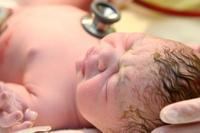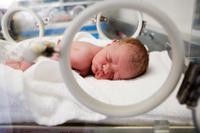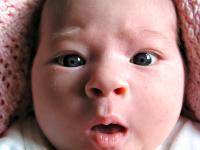-
- Your baby’s skin may be covered with vernix, a slippery white coating that protected your baby’s skin during pregnancy. There is no need to wash it off, it will absorb into your baby’s skin in the first 24 to 48 hours.
- Milia are white spots that may appear around your baby’s nose. Although they may last for a few weeks, they do not need to be treated. Washing with plain water is all that is needed.
- Lanugo is the fine downy hair that may be found on your baby’s forehead, ears and shoulders. It usually disappears by two months of age.
- Your baby’s skin may be dry or peeling, especially on their hands and feet. Your baby has come out of a very moist environment to one that is quite a bit drier. The baby’s skin will usually adjust over the first few weeks without the need for moisturizers or oil. Newborn rash, which is a blotchy, red pinpoint rash, is very common in the first month and will usually go away on its own. If you are concerned about any rash or skin condition always contact your healthcare provider.
- Mongolian spots are black or blue spots that may be found on any part of the baby’s body, but usually on the back or bottom, if the baby has any at all. These spots usually fade by five years of age.
- Storkbites are reddish areas that may appear on your baby’s forehead, eyelids, nose or back of the neck. These fade and usually disappear by 24 months.




Your baby’s head



- Soft spots. There are two soft spots, called fontanelles, on the top and the back of your baby’s head where the bones of the skull have not yet joined. The bones grow together as our baby gets older. Gently touching the soft spots will not harm your baby.
- Hair. Your baby may have lots of hair or none at all. Babies may lose some of their hair shortly after birth. Your baby’s hair may also change colour.
- Eyes. Babies love to look at their parents’ faces. Studies have found that full-term newborns can recognize their own mother’s face as early as four hours after birth. Your newborn’s vision is best at a distance of about 8-10 inches (20-25 cm). The eyelids may be swollen for a few days after birth, but this will go away on its own. It is quite common for a baby’s eyes to change colour during the first year.
- Nose. Due to the birth, your baby’s nose may be temporarily bruised or misshaped. In the days following the birth, the appearance of the nose will change.
- Head shape. As the baby is being born, five boney plates in the head overlap, this can give the baby a cone or mis-shapen head appearance at birth. It may take up to 6 weeks for your baby’s head to become rounded.
Flat areas on the head
The skull bones are soft until about one year of age. As a result, flat areas on the head can develop very quickly (often within the first two months). Babies who lie on their backs looking straight up may develop a flat area on the back of the head (brachycephaly). Babies who tend to lie with their heads turned to one side may develop flatness only on one side of their head (plagiocephaly), which can lead to changes in facial symmetry. Plagiocephaly will change your baby’s appearance but do not affect your baby’s mental or physical growth and development. However, the changes in appearance can be permanent if not addressed as early as possible.
Preventing flat areas on the head
When your baby is sleeping:
- Place your baby’s head at the opposite end of the crib every other night. For example, lay your baby one way on even days, the other way on odd days. Your baby will tend to turn towards any noises, e.g. the sleeping parent or noises in the house
- Change your baby’s head position during sleep. For example, place your baby’s head to the left for one nap and to the right for the next nap. If your baby likes to sleep directly on the back of their head, try to encourage them to turn their head to alternate sides or do side-lying as well as tummy time when the baby is awake
- If your baby always wants to look in one direction, try to position their head in the other direction as much as possible
- Unless advised by your doctor, do not put your baby to sleep in a car seat, bouncy seat or swing and limit the time your baby is using these devices when they are awake
- Do not use sleep devices such as wedges or rolled up blankets or towels to keep your baby in position. Once your baby starts rolling over he or she can choose their own sleep position
Giving baby tummy time

One of the best things you can do to prevent a flat area on your baby’s head is to provide early supervised “tummy time” when your baby is awake. Tummy time also helps your baby:
- Strengthen the muscles in the neck, shoulders and back
- Develop early head control
- Develop arm reach
- Learn to roll over
- Learn to crawl
It takes time for your baby to develop the muscle strength to enjoy this position and they may fuss at first. Start by laying your baby on their tummy on your chest while you lie in a reclined position. You can also place your baby on their tummy across your lap. Note: these positions are not safe for sleeping.
Another idea is to roll up a small towel and place it under your baby’s chest, placing their arms in front of the towel. This will make it easier for your baby to hold their head up.
Young babies will not be able to hold their heads up but you can still place them on their tummy’s when awake and position them to look in alternate directions.
Another good play position for your baby is side-lying. Placing a rolled up towel behind your baby’s back and in their tummy when playing in this position will prevent your baby from rolling.
For more information on head shape and other positioning ideas, check to see if there is a head shape class in your area and visit the following website:
Other things about your baby
For the first few days, your hormones may cause changes in your baby, such as:
- Swollen breasts (and sometimes milk)
- Enlarged genitals
- A small amount of bleeding or mucus discharge from the vagina
Your baby will have a small sample of blood taken from their heel when they are between 24 hours and seven days old. The blood sample (called a newborn metabolic screen) will be tested for seventeen conditions, three of which are:
- Hypothyroidism (under-active thyroid)
- PKU (Phenylketonuria)
- Biotinidase Deficiency
These three conditions are are all treatable by either diet or medications. If the conditions are not identified soon after birth and treated, they lead to serious health concerns and developmental problems for the baby. After the blood sample is taken, you will be contacted only if the test needs to be repeated or is abnormal. Read more about the Newborn Metabolic Screening Program.
Circumcision is the surgical removal of the skin (foreskin) covering the tip of the penis. Some parents choose to have their child circumcised for religious or cultural reasons. Newborn circumcision is not covered by Alberta Health Care and is not a medically advised procedure.
If you are considering having your child circumcised, ask your doctor for more information.